The Lost Art of Writing Love Letters
Observations from Kyle Abraham’s Residency work with Michigan LGBTQ Youth

Choreographer Kyle Abraham. Photo courtesy of the artist.
Never before have I found myself in a group of “strangers” whom I felt I actually knew quite well. We were sitting in a large circle in a white, bright room in the Affirmations center of Ferndale, Michigan, roughly 40 minutes out from Ann Arbor.
The group was richly diverse in age, style, perspective, and gender. Many in the group were young people from the Metro Detroit area who identify as LGBTQ. Others in the group were UMS staff and adult leaders and volunteers of the center. Regardless, after just a few days of experiencing workshops together under choreographer Kyle Abraham’s lead, participants were comfortable with sharing something they loved about the people sitting next to them. At the beginning of our first meeting earlier that week, we had shared only our names and preferred gender pronouns. In the time between, Kyle and some of his company members had created a transformative, interactive experience for their dance research and for the hearts of each participant.

Kyle’s New York-based contemporary dance company Abraham.In.Motion has a mission to “create an evocative interdisciplinary body of work.” To help deepen the development of Kyle’s newest work, which he currently calls Dearest Home, UMS hosted the choreographer and four of his company members for one week.
The artists spent nearly ten hours at Affirmations, where they shared the progress on their choreography, asked for feedback, led discussions on the core themes of the work, and even taught some movement to the group who had gathered to participate. As a former 21st Century Artist Intern with UMS, I was lucky enough to sit in,observe, and absorb. (My colleague Sophia Deery spent a whole summer with Kyle in the same program. You can read about her experience.)

To start, Kyle led an open conversation about healthy relationships, a vulnerable topic but a productive discussion. The group ultimately came to important conclusions, for example, happiness is an identifier of love, not a product of love, which led us into our next activity. Kyle directed us to a table full of magazines, color pencils and markers, envelopes, scissors, glue sticks, and more. He asked everyone to write a good old-fashioned love letter, a gesture he described as a lost art. He turned on a playlist and let all of us, including his company members, sit together and work on our small expressions of love. We wrote love letters to friends, romantic interests, and even ourselves. Some words that were thrown around in the reflective discussion that followed the activity were “insecurities, easy, hard, weird, nice.”
Kyle’s playlist continued filling the room as we transitioned into our next activity, which involved huge, white pieces of blank paper taped to the walls. Kyle asked us each to recall some of the words that were used in our first group discussion and to visualize them, as literally or as abstractly as we wished, on the wall. Within minutes, the walls were full of “blooming, touching, dream, cuddle, risk,” and more.
Kyle’s dancers then shared a trio of choreographed movement that they had worked on in the dance studio that week. More word associations were thrown out from the group in response to the choreography. Some of the group saw petals in the dance, others saw comfort and support, and others saw the healing powers of touch and love.

The next excerpt of choreography, this one a duet, got drastically different reviews. First danced for us in silence, this duet was associated with “anxiety, separation, unsettling.”
Kyle asked the dancers to execute the same choreography again, this time to music he had used while creating it. He explained to the group the significance and influence of this music on his choreography. He shared that he sometimes spent years working on a playlist for a dance piece before actually beginning his work on the movement, and the playlist doesn’t necessarily become that dance’s sound score, but may be used otherwise in the final product. For example, he had the playlist used to create the dance piece Radioshow as pre-show music at the theater, music that played as the audience filed in. The dancers felt that their silent run-through of the choreography made them more dependent on each other’s timing and left a lot of decisions to their creative imaginations. The run with music, alternatively, provided them with more context and drive. Some members of the group preferred the intimacy of the silent run-through, and others appreciated watching the influence of the music.
The discussion on music continued as Kyle asked us each to create our own Love Playlist for TODAY by gathering a collection of music that was relevant to our feelings in that exact place and time. I thought about all the channels of love I felt in that specific moment: love for family, friends, self, dance, people, romantic love. I began jotting down as many relevant songs as came to mind. We each shared highlights from our playlists with each other and bonded over mutual musical interests. I remember smiling and shaking my head in disbelief at the fact that just from hearing some song titles that came to mind when people thought about love, I could get a strong context for how they are doing and feeling in their personal lives.

Kyle then showed videos of his previous works, including Radioshow and Watershed, a piece that was presented recently through UMS. He explained that within his creative process, he has also used his playlists to improvise movement, and then his dancers learned choreography by studying videos of his improvisations.
He also teaches the dancers new phrases bit by bit, as he invents on the spot, and asks dancers to “catch what they can” throughout his improvisation. He showed us an example, as he improvised and then Penda, one of the dancers, created her own adaptation of that phrase. Suddenly, the company had a multiplication of movement material to work with and develop furthermore for the growing piece.

Another strategy that Kyle uses to generate movement in this piece is retrograding a phrase of choreography that already exists. This essentially looks like the same movement, just done backwards, as if on a rewind function. Additionally, Kyle uses action words like “dive, jump, snake, slide, and twerk” to direct his dancers in improvisational exercises to create new movement. He is also inspired by simple, human gestures; pedestrian movements that we all see every day like a nod of the head or a wave of the hand. The dancers showed examples of movement created from all of the above strategies. We even got to learn an excerpt of the gestural phrase and get up and try dancing across the room to some of Kyle’s action words.

Kyle later returned to the topic of our individual Love Playlists. He instructed the dancers to show us some choreography while each of us listened to a song from our personal playlists. Some participants were amazed at how musical the dancing was, even when the dancers themselves could not hear our individual songs that were playing through our personal earbuds and headphones.
This connection between the music and the dancing, both revolving around the theme of love, inspired us to create album covers for our playlists. I looked over my colorful album cover, my collage of words in my love letter, my playlist of happy and sad love songs, and I realized that my own experience with the themes that are fueling Kyle’s new work channeled through my own life in so many ways over the course of that week. The majority of the room had the same experience.

Kyle’s new piece seems to be a love letter in itself. It is full of vulnerability and honesty. It is inspired by the pieces of his personal life that are closest to him: his history, his home, his identity. It explores and celebrates just how human the art form of dance is. I felt validated as a dance artist because I could see the change in the participants of Kyle’s residency. Their closing remarks revolved around a majority opinion that they now saw dance as relatable, emotional, and human. This new work is sure to be a love letter to that sentiment.
Dance Renegade: Choreography of William Forsythe
Editor’s note: As part of the UMS 21st Century Artist Internships program, four students interned for a minimum of five weeks with a dance, theater, or music ensemble part of our 2015-2016 season. Meri Bobber is one of these students. This summer, she was embedded with Hubbard Street Dance Chicago.
Below, Meri shares her travel stories with the company in advance of their return to Ann Arbor on October 27, 2015.

Photo: Moment in “Quintett” by choreographer William Forsythe. Photo by Cheryl Mann.
Meri’s note: My summer at Hubbard Street offered me some personal insight and experience with the work of world-renowned choreographer, William Forsythe. I met him and heard him speak at the company’s annual gala this June, researched his career as I helped write visa applications for his German restagers, experienced being in rehearsals with him and the Hubbard Street dancers, and conducted interviews about his work with Hubbard Street’s Meredith Dincolo, Glenn Edgerton, and Kevin Shannon. On October 27, Hubbard Street Dance Chicago brings a production of Forsythe’s choreography to Ann Arbor.
Forsythe’s History
American-born William Forsythe made his choreographic debut in 1976 after dancing professionally for companies including the Joffrey Ballet. He then went on to serve as the resident choreographer of Ballet Frankfurt in Frankfurt, Germany until its closing in 2004. He founded his own company, The Forsythe Company, with many of the same dancers and continues developing his work abroad.
Movement aesthetic
Forsythe is widely credited for radically rethinking and reinventing ballet. He uses balletic concepts such as épaulement (a type of shoulder movement) in many of his works, but infuses the foundational technique with new ideas and fresh contexts. His movement language explores the geometric possibilities of the body as it moves through space, challenges verticality, employs torsion and spirals, and explores lines, points, and curves. Hubbard Street’s Artistic Director Glenn Edgerton said in an interview this summer that Forsythe’s perspective and work “has changed the face of dance.” Retired Hubbard Street dancer Meredith Dincolo, now artistic associate and coordinator of pre-professional programs, added, “In classical dance and in contemporary dance, you can’t deny [Forsythe’s] importance.”
Forsythe as a collaborator
Forsythe’s work can be highly collaborative, academic, and technology-driven. He has developed his own computer software and improvisation technologies that explore geometrically influenced movement generation. Additionally, he has collaborated with The Ohio State University to create an interactive website which examines One Flat Thing, reproduced, one of the pieces that Hubbard Street will perform for our audiences. Forsythe’s work “made science and dance come together,” says Edgerton.
One Flat Thing, reproduced by William Forsythe from dance-tech.TV on Vimeo.
Creative process
Forsythe’s dancers are treated as essential collaborators throughout his creative process. On September 30, 2015, in a conversation with Hubbard Street’s Zac Whittenburg, Forsythe articulated that his choreographic process consists of giving his dancers the substantive ideas, shapes, tasks, and themes (the “what”). The dancers then bring these to life in the studio (the “how”). Those working to set the rep on Hubbard Street’s company are all dancers who participated in the original casts of the works. Glenn Edgerton believes the process of learning, rehearsing, and performing Forsythe’s choreography will “change and broaden [the Hubbard Street dancers’] perspective” on dance, influencing the rest of their careers. Hubbard Street dancer Kevin Shannon agrees. This summer, he said that he’s excited to focus on one choreographer’s work for several months, because especially with Forsythe, “it is all about the process.”
Future
Now 65, Forsythe is retiring as artistic director of The Forsythe Company and will soon be on faculty at the new Glorya Kaufman School of Dance at the University of Southern California. His educational efforts in America will begin to contribute to the propulsion of “what’s next” in American contemporary dance. The contemporary dance community of the United States is highly anticipating his return.
Forsythe in Ann Arbor
The William Forsythe program that Hubbard Street brings to Ann Arbor will restage three of Forsythe’s most impactful works: N.N.N.N., Quintett, and One Flat Thing: reproduced. This selection of works exemplifies Forsythe’s signature movement language while also proving his diversity as a choreographer as the three pieces vary greatly:
- N.N.N.N. is a quartet originally set on four male dancers. The HSDC restaging is challenging the role of gender and inter-gender relationships by substituting women into some of the roles. The choreography is precise and fearless and moves like mechanical clockwork. The dancers’ limbs intertwine and bounce off one another’s bodies as the group moves through space.
- One Flat Thing, reproduced was created in 2000, recreated on film in 2006, and was originally set on 14 dancers with 20 large, identical tables. The tables create grid-like negative space on stage, and the dancers maneuver over, under, and around this space in solos, duets, trios, and larger groups. The piece is a massive puzzle of visual and aural cues, and requires the dancers to pay explicit attention to one another’s timing. This is the kind of piece that’s always happening: if you blink while watching, you’ll miss something.
- Forsythe’s late wife inspired Quintett. Five male and female dancers move to exhaustion to the repetitive music of Gavin Bryars. The choreography exemplifies Forsythe’s geometric interests and explores grief by taking the dancers on a journey to a state of extreme physical fatigue. Hubbard Street dancer Kevin Shannon confirms that this is “one of the hardest pieces I’ve ever danced in my life… the state of exhaustion you reach creates a connectivity [with the other dancers] that you don’t see in other pieces. By the end, you have to let go and find a deeper place within yourself.” Meredith Dincolo describes Quintett as the most intimate of the works we’ll see, pairing well with the other pieces to give a “broad spectrum of William Forsythe’s work.”
Hubbard Street Dance Chicago returns to Power Center with an evening of works by choreographer William Forsythe on October 27, 2015.
Interested in more? UMS Artist Services Manager Anne Grove was once company manager of Hubbard Street Dance Chicago. Read our interview with Anne.
Student Spotlight: Embedded with Hubbard Street Dance Chicago
Editor’s note: As part of the UMS 21st Century Artist Internships program, four students interned for a minimum of five weeks with a dance, theater, or music ensemble part of our 2015-2016 season. Meri Bobber is one of these students. This summer, she was embedded with Hubbard Street Dance Chicago.
Below, Meri shares her travel stories with the company in advance of their return Ann Arbor on October 27, 2015.
Assume nothing; be curious. This approach to artistry is something I learned from choreographer William Forsythe at Hubbard Street Dance Chicago’s Spotlight Ball on June 1, 2015. The glamorous night was a celebration of dance and highlighted the success and impact of Forsythe’s work, as the main company prepared to perform his choreography in its upcoming season. By the night of the gala, I was already a few weeks into my internship, but I carried this advice with me as I continued my summer in Chicago as a UMS 21st Century Artist Intern.
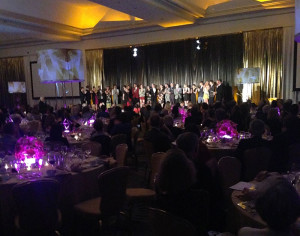

On left, the gala was held in a ballroom of the Fairmont Hotel in downtown Chicago. In this shot, dinner guests applaud as Artistic Director Glenn Edgerton introduces all the professional dancers of Hubbard Street. On right, Hubbard Street’s second company, comprised of early-career artists, perform a movement composition exercise to supplement the dance education of Chicago elementary school students.
My internship at Hubbard Street was structured so that I would rotate departments weekly for two months. This structure ultimately proved to be incredibly appropriate, as I saw firsthand that non-profit organizations require their employees to wear many hats, big and small, simultaneously, and to still maintain the ambition to learn on the fly, to jump in wherever he or she is needed. For example, the accounting manager at Hubbard Street also serves as IT. A former professional dancer of the company is now its Manager of Communication on the marketing team. When I joined the second company for a day of several dance outreach performances at Chicago area schools, the artistic director drove our van.
I practiced the same adaptability in my internship, beginning in artistic administration, where I was trusted with an important, ongoing project right away. One of the repetiteurs from The Forsythe Company was to come to Chicago and set three of William Forysthe’s works on the dancers for the performance Hubbard Street will bring to Ann Arbor in October. As an artist of German citizenship, he needed a visa for his work in Chicago. So, although I bounced around departments, I worked throughout my internship to research this repetiteur’s career, assemble resources, and write a coherent paper about him that proved the legitimacy of his trip and his work at Hubbard Street. I needed to present enough evidence to prove that he was the best and only man for the job. My supervisor worked closely with me on the project, taught me how to address the guidelines required by the government, and left me confident with a new, important skill. One of my highlights from the summer was the day that my supervisor informed me that the application had been accepted by the government. I met him in person later on, and his gratitude for my help with his application touched me. The work I had put into it proved successful for Hubbard Street and the Forsythe production.
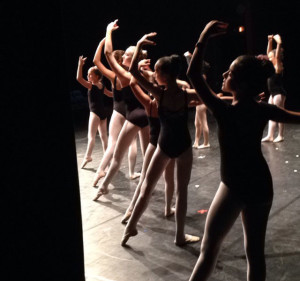
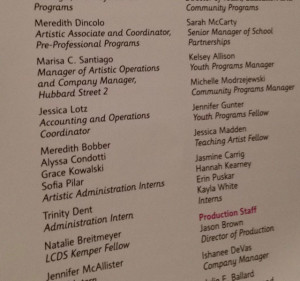
On left, a shot from backstage of the Hubbard Street Youth Showcase where I helped the professional dancers of tomorrow make it on stage in time for their numbers. On right, I spent the week leading up to Hubbard Street’s Summer Series at the Harris Theater helping out at dress rehearsals backstage. It was a treat to find my name included on the Hubbard Street Staff listing in the program on opening night!
I switched responsibilities each Monday. I served in the marketing department, where I initially felt far out of my comfort zone but ultimately learned a lot in just five days; the youth education department, where I made great friends with other interns and helped the youth showcase recital run smoothly; backstage of the Harris Theater downtown, where I assisted Hubbard Street’s main company manager during a production that featured the work of resident choreographer Alejandro Cerrudo; and the development department, where I learned about external affairs and donor profiling, and helped out behind the scenes at the aforementioned gala. And that’s just to list a few!
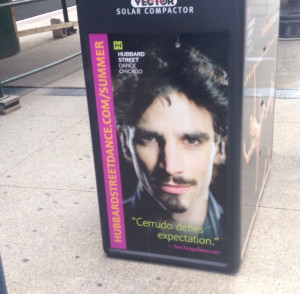

On left, Hubbard Street marketed the Summer Series show with ads like this all over street kiosks downtown. It was fun to learn about such marketing strategies at work, then go see them in action on my walks to and from the theater. On right, Hubbard Street’s Resident Choreographer Alejandro Cerrudo signed my program on closing night of the Summer Series.
Following the internship, I stayed on for a third month to participate in the college-level summer dance intensive. This is a program I enjoyed thoroughly last summer as well. I was happy to have Hubbard Street’s artistic staff, alumni, and current dancers give me another satisfying amount of choreography to study and a technical kick-in-the-pants. The training tested my adaptability as a dance artist, connected me with talented young dancers from around the country, and filled gaps in my technique. It was a special experience to come to the building every day and spend 8 hours in the studios just as Hubbard Street’s professional dancers do. I studied ballet, yoga, Pilates, improvisation, Gaga technique, Horton technique, partnering, and a variety of diverse repertory excerpts that required me to dance with different qualities and intentions. I sweat. A lot.
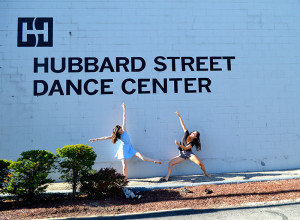

On left, one of my closest friends from school, Lena Oren, came into Chicago for the summer intensive. Here we are dancing outside of Hubbard Street’s building, located on Jackson Boulevard and Racine Avenue. On right, the summer intensive concluded with an in-studio showcase, which offered my fellow dancers and me the opportunity to perform the repertory excerpts we had been studying for the past four weeks.
Beyond working and dancing at Hubbard Street’s building in the West Loop, I found that living in Chicago in the summertime was delightful. I grew up in Milwaukee, but hanging out on Lake Michigan’s lakefront never gets old. The Brown Line to Kimball route of the Chicago Transit System (the “L,” as locals call it) offers stunning views of the downtown Loop. The Taste of Chicago food festival, the Bean, Buckingham Fountain, and the city’s diverse and characteristic neighborhoods gave me much to do and explore. I had the priceless company of my older sister, who has lived in Chicago for more than a year now, and my best friend from school, who traveled from California to participate in the summer intensive at Hubbard Street with me. We ate out, walked the lakefront, hung around Clark Street, and attended street festivals, parades, and shows. I also used my weekends to attend dance classes and shows anywhere and everywhere in an attempt to acquaint myself with Chicago’s greater dance community.
I subleased two apartments during my three months there: one from a coworker at Hubbard Street, a 15-minute walk from the West Loop (where Hubbard Street’s building is located) in the quaint, historic Little Italy neighborhood of Chicago. The other sublet was more of a gamble. I lived with a stranger far uptown at Lawrence and Clark, a location that required me to learn how to navigate Chicago’s public transportation system each morning in order to get to work. In terms of my mysterious roommate, I actually got very lucky. I lived with a Chicago and dance enthusiast who showed me around the city, specifically the characteristic area of Lincoln Square, and has become one of my closest friends.
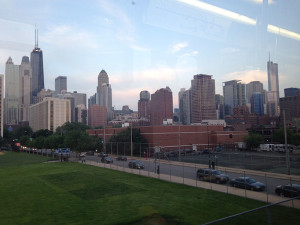
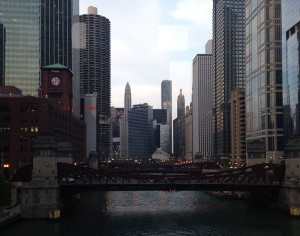
On left, Chicago skyline from the Brown Line train north to Kimball. On right, downtown loop of Chicago from the Brown Line train north to Kimball.
And so, both inside and outside of Hubbard Street’s building, my summer in Chicago fulfilled and excited me day-by-day. The pressure of having new assignments and needing to catch on to the operations of a new department at Hubbard Street every week honestly made me a little anxious on Monday mornings (especially during my week in marketing, an area in which I had no previous experience). The variety of choreography I studied during the intensive also required me to be flexible, in more ways than one! So I learned to adapt to the diversity in both the office and the studio, and to do my best with all that was thrown my way.
My to-do list throughout those three months was anything but monotonous. Every morning when I arrived at the building, I knew I could be asked to do just about anything to help make dance happen. I rolled out a marley floor. I organized video archives. I sifted through the dusty costume cage in the back warehouse. I wrote and I researched. I faxed and I answered phones. I brainstormed and I went to meetings. I ordered and picked up gifts for the choreographer on opening night. I ran the video camera at technical and dress rehearsals. I went to dance class and came back day after day with more sore spots and bruises. I cared to finesse the individual details and qualities of each piece I was taught. I tried assuming nothing and being curious all summer long, and it was an impactful approach to my working to bridge my student experience with becoming a professional.
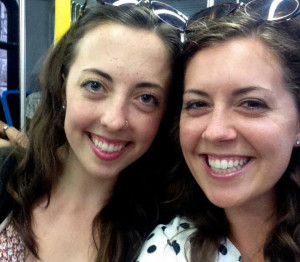
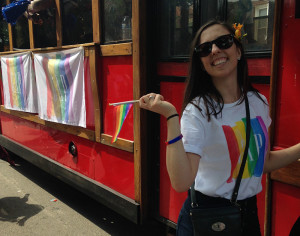
On left, my Chicago-based older sister and I on a city bus. On right, Here I am at the Chicago Pride Fest, one of the many summer city activities I soaked up. Others included Taste of Chicago, the Blackhawks Stanley Cup Victory Parade, and free concerts at the outdoor Jay Pritzker Pavilion.
I left Chicago with a big-picture understanding of the many factors that make up the dance powerhouse that is Hubbard Street Dance Chicago. The organization offers more than 70 classes a week to the public, rents studio space out to dance projects and companies, holds special dance education workshops through The Parkinson’s Project and The Autism Project, educates young dancers in a variety of dance styles, practices dance outreach in Chicago’s public schools, develops early career artists through the second company, and produces professional shows that feature a wide range of choreography on national and international stages.
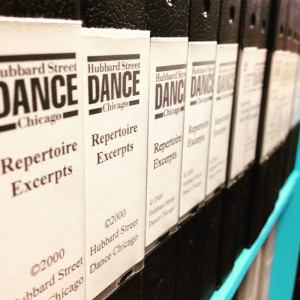
I spent one afternoon getting lost in Hubbard Street’s media room, which contains rehearsal and performance footage that dates back to the 1980s.
I now have a personal understanding of the effort, talent, teamwork, and dedication it takes to maintain such an umbrella for dance. The company dancers themselves are no less exceptional. They are thoughtful, articulate, versatile movers who appear almost invincible in the studio and in performance. When they grace the stage of the Power Center this October, you’ll see what I mean.
Hubbard Street Dance Chicago returns to Power Center with an evening of works by choreographer William Forsythe on October 27, 2015.
Interested in more? UMS Artist Services Manager Anne Grove was once company manager of Hubbard Street Dance Chicago. Read our interview with Anne.


